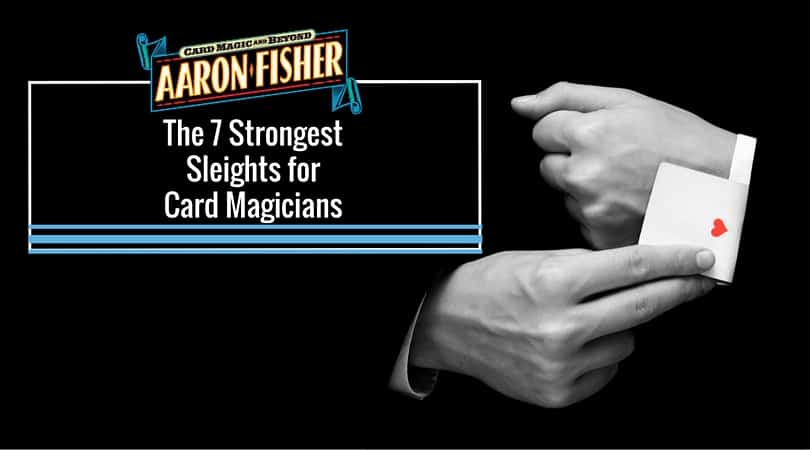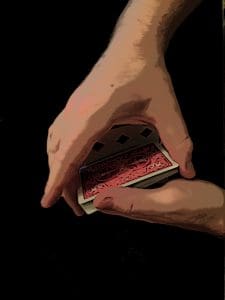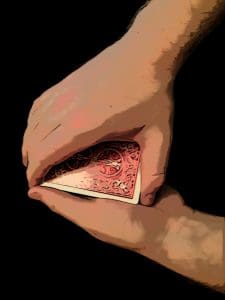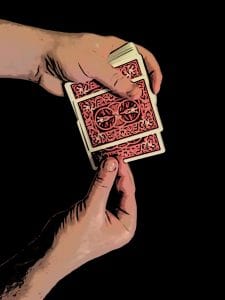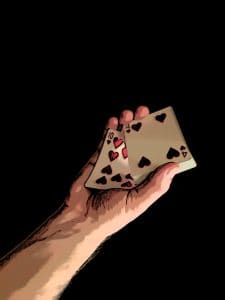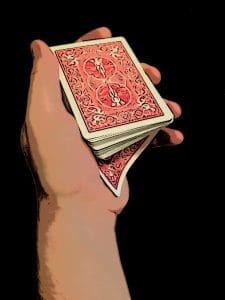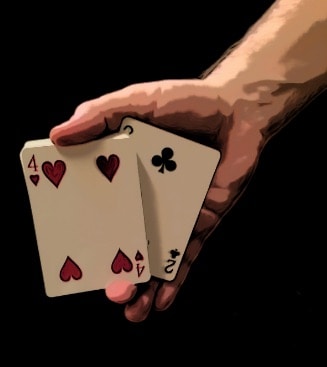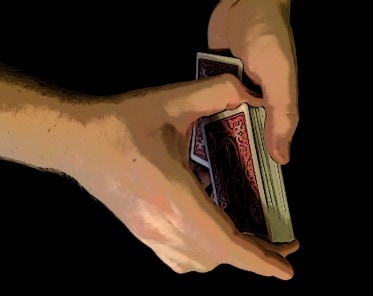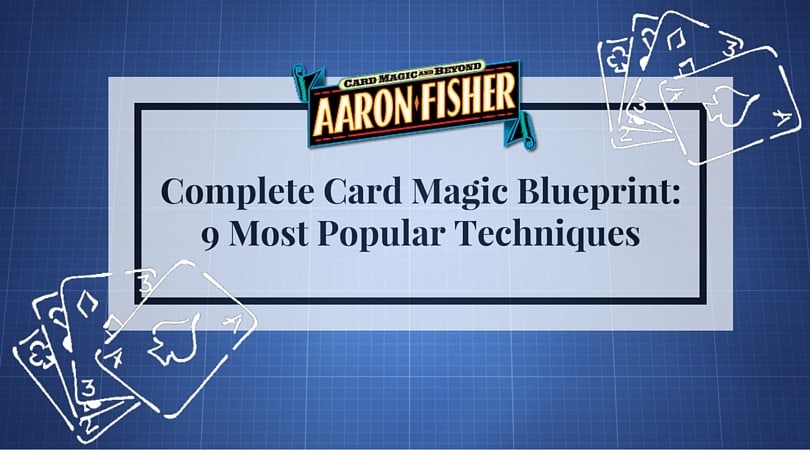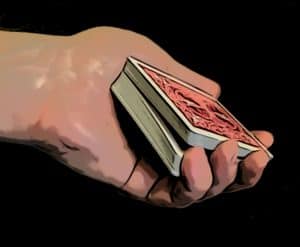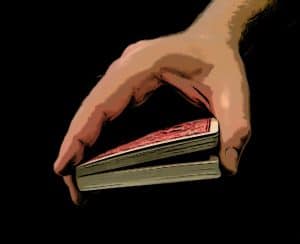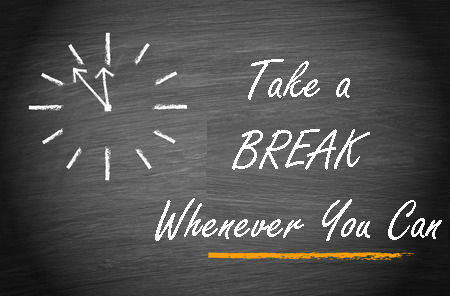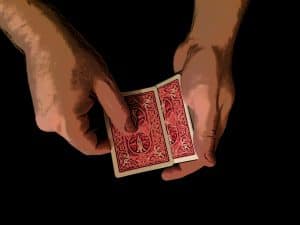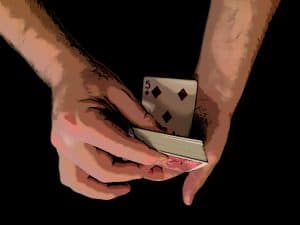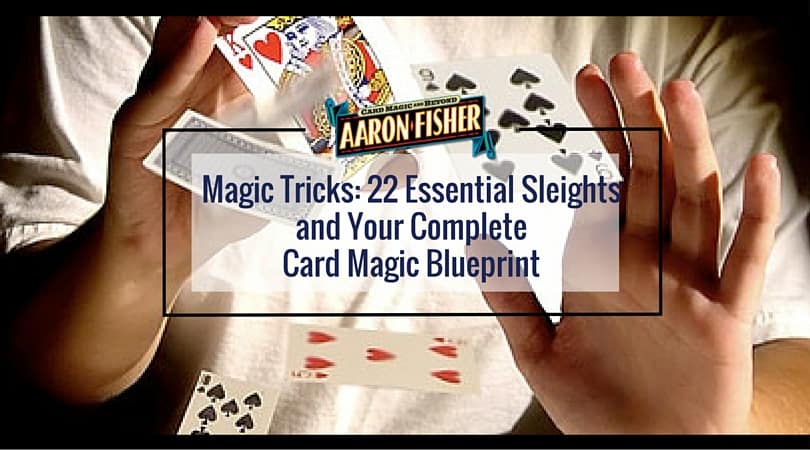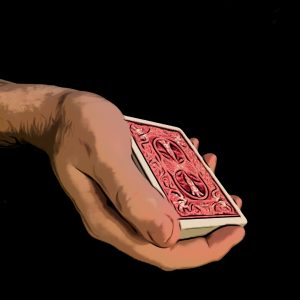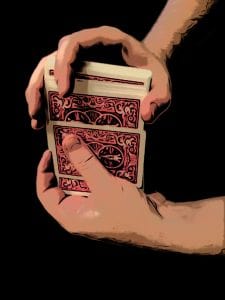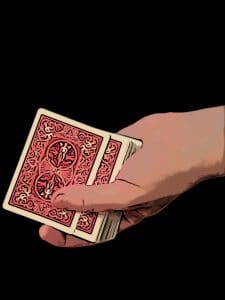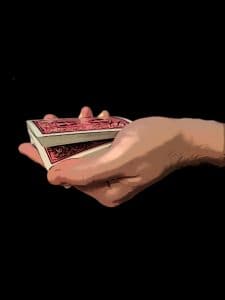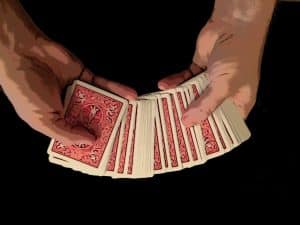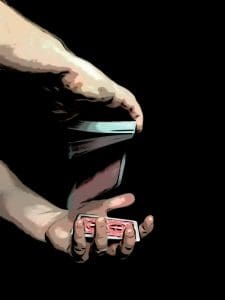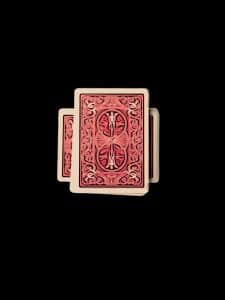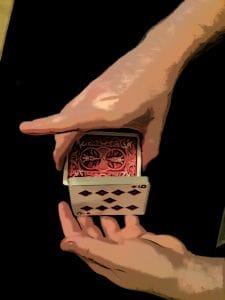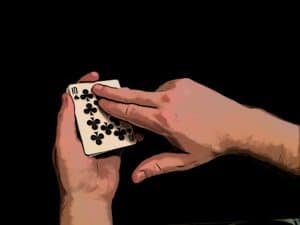Thumb Tip magic tricks are some of the best effects in ALL of magic. The Thumb Tip is one of the most powerful and versatile tools available to magicians, and it unlocks a huge range of astonishing effects. In this video, you’ll discover some of the MOST powerful effects you can perform using a Thumb Tip…
Speaker 1 (00:00):
What’s up and welcome. I’m Aaron Fisher and I’m here with Adam, Alex, and Steve from Chondra community, the world’s best magic club. Now in this video, you’re going to get a taste of what a great magic club can offer you. Real secrets for passionate magicians, impossible tricks and pro training you aren’t gonna see at any other magic website. So please do us a favor if you like what you see, hit like and subscribe to the channel so you’ll be notified every time we go live with a new video. So Adam, what are we going to do today? Ah,
Speaker 2 (00:29):
what are we going to do today? Well, we’re doing a lot today. My friends, uh Oh wow. Sorry about that. Uh, we are actually going to look at something that I think is overlooked a lot in magic. Okay. Probably one of the most overlooked things and probably one of the most underused things because people often say, eh, I’ve seen that before. I’ve dealt with that before, but we’re going to be looking at the thumb tip. Now our members ask for the show. They ask for a little in depth training, didn’t they? Alex. Yes, definitely. They definitely did. They asked for this. So today we are going to hit the thumb tip hard. We’re going to hit it with a tractor, then we’re going to hit it with a backhoe and then we’re going to dig in and we’re going to teach you everything you need to know about the thump tip. Did you just ask me what a backhoe is? Sorry, you’re on mute, Aaron.
Speaker 1 (01:26):
[inaudible] everything you need to know with a backhoe.
Speaker 2 (01:31):
Yeah, yeah, yeah. Do you know what a backhoe is?
Speaker 1 (01:33):
I have no idea. I don’t even know what Pronto is, although I think I met one or Atlanta.
Speaker 2 (01:39):
Uh, well a backhoe is, uh, well yeah. Well we’ll talk about that on another show. So in any way, what are we going to start out with today on the old,
Speaker 1 (01:49):
Oh, that’s a good world. Well, I think we wanted to, uh, start by having Alex give us an example. Ah, what a drag. We, we’ve divided our first rule. Alex, why don’t you show us a quick trick to get started with and uh, you know, that’s what happens when you do a training on a specific topic, isn’t it?
We hope you’re enjoying this discussion of the best Thumb Tip magic tricks. Remember, you can scroll up and check out the video above to see what we’re talking about.
Speaker 2 (02:07):
It’s there happens. What are you going to do? What are you going to do? All right, let me go. Yeah, yeah, yeah. I want to go to Adam on this. Okay. All right. We’re going to show it. Here it is. Uh, this is, uh, this is awesome. Amen. Alexander slimmer and his favorite trick.
Speaker 3 (02:25):
It’s the grid one. Man, this is a good one. I almost hate to give it up, but I think it’s, it’s time. It’s time to talk about this actually needs some help. Steve, do you mind helping?
Speaker 1 (02:36):
No, I would be happy to help.
Speaker 3 (02:37):
You’d be happy to help. This is awesome. I need you to pretend for me. Pretend that we’re hanging out in the same room. You know, it’s weird and we have the internet between us, but uh, pretend we’re in the same room. I have some sugar packets here. If we were at a restaurant, I would give you the sugar packets on the table. Pick a sugar packet. Any packet.
Speaker 1 (02:57):
Uh, let’s go with that one. All right. How
Speaker 3 (03:00):
about this one right here? Yeah, that was actually the one that was pointing at. That’s actually the one you were pointing out. This is perfect. I’m going to do something. I have a pain here. I’m going to just write on the sugar packet here and make it simple as if you wrote it.
We hope you’re enjoying this discussion of the best Thumb Tip tricks. Remember, you can scroll up and check out the video above to see what we’re talking about.
Speaker 4 (03:12):
And uh,
Speaker 3 (03:14):
there we go. Put a little Mark on the sugar packet. Yes, could be your name, could be anything, but I take the sugar packet and it’s very simple. I just rip off the tip of the sugar packet just like this, and I get a little bit of sugar and I just dump it into my fist just like this. You can see it go down in there and when I drop this in here, get even a little piece. It’s like a receipt. I push it down in here and hang on. There’s a couple of little little greens that went there. I just do this, give it a little, a little blow comes back together. In fact, there’s your little Mark. You can see that’s your sugar packet. That is sweet and low.
Speaker 4 (04:00):
[inaudible]
Speaker 1 (04:02):
yeah,
Speaker 3 (04:06):
a quickie and a lovely, a little illusion there, man. I say little, but uh, bring that to my dinner table anytime. Yeah.
Speaker 1 (04:15):
So here’s the thing. Uh, you know, I just remember discovering this when we were teaching magic and magic camp in Canada all those years ago. But I have every bet that it applies to everyone watching this right now. Uh, most magicians who’ve been in magic for any length of time know what a thumb tip is. No. That it’s an incredibly versatile thing. Know that great magicians throughout history have always recommended, right? And don’t use it themselves. In fact, they tend to be frightened of it. Let’s just go ahead and ask in chat. How many of you literally are a little bit scared of actually doing the thumb tip? Cause you’re afraid you’re going to get caught with a plastic thumb on your hand. Look at that. [inaudible] a lot of really skilled, experienced guys and people avoid it really like a dentistry because they’re scared they’re going to get caught with a phone on their hands.
We hope you’re enjoying this discussion of the best Thumb Tip magic tricks. Remember, you can scroll up and check out the video above to see what we’re talking about.
Speaker 1 (05:08):
Now I remember and a lot of us had the same experience when I was a kid, I was purchased a thumb tip and a silk from the local magic store and I did it for my parents and I went to [inaudible] and they could see it and I resolved never to do it again. Right? And I didn’t for, and I wouldn’t have maybe done it for 20 years except I went off to work for a magic store when I was 18 years old and I was taken to Atlanta to train for this national magic store. And the very first day I was taught the trick that you’re about to see. So we’re going to show you a lot of really cool thumb tip applications today. Wonderful tricks you can do. But we’re going to start with not only an incredibly visual trick, but a trick that’s designed specifically to help you get over that so that you can be comfortable with a thumb tip on your hand and be able to use it to create a whole lot of miracles. Uh, this is, uh, a clip from one of our first member trainings. Uh, Adam is going to show us a trick, uh, of me performing it. Please pay no attention to any different health issues you see in my face.
Speaker 5 (06:23):
Hi everybody. Aaron Fisher here and you may know me for card magic, but right now I’m going to show you something a little bit strange. This is the most clear representation I can give you of how magicians view reality as being slightly different than your average folk. You see on one sense, reality is clear, present, substantial, real, but in another, just like this handkerchief, it’s transparent. A theorial totally up for grabs. Before you know it, it’s back just the way we started and it’s right in front of you again. We’ll try this again. Watch carefully. Take this handkerchief.
Speaker 4 (07:08):
Well put it in my hand and like so
Speaker 5 (07:17):
and it’s gone completely. And in fact, well that’s strange. I suppose we’ll move on with the card trick. Would you take those out of the deck and of course my audience does and they find something they never expected in a million years. That’s the perfect opener. Now we’re going to talk about what it is, what you need to do it yourself.
Speaker 2 (07:41):
Yeah man, I love that. I love that Aaron. It is that to me that’s the perfect, it really is the perfect train on how to use a thumb tip. There’s so many little touches there that I think people, if they could, if they can just grasp like the two or three little fundamental things about what you’re doing, they will feel totally comfortable approaching using the thumb tip, uh, in, in everyday situations. Um, you know, right off the bat, I mean there’s lots that I can notice, but I don’t want to jump on your a thunder. Is there something you’d like to start out by saying?
Speaker 1 (08:16):
Yeah, well first I only had to do it two times before I could do it. And I’ve never been able to forget it since. So I was terrified the first time I did it right and I didn’t do it great. And then the second time I did it, it was fine. And then, you know, I did it a thousand times in the next couple of years. So I recommend that you grab a thumb tip and if you have a magician silk, go through this with me
Speaker 1 (08:41):
with the office can say cards in hand with the stuff in your hand because it’s really all about learning these simple movements. What’s beautiful about the silk, Manish, is it’s colorful. People can see it. It’s big and it’s a way to make something big that people perceive, takes up a lot more space than it actually takes up, disappear, really disappear. And you’ll find that not only will you learn how to handle the thumb tip comfortably so that you can use it for all kinds of stuff, but you’ll actually find yourself performing it. Now, uh, as I recall, a six inch dye, a six inch cut silk is ideal for a standard thumb tip for most people. Um, I at one point a few years ago bought a diamond cut soap because they were even bigger. If I had it to do over again, I would probably just stick with a standard six inch silk.
We hope you’re enjoying this discussion of the best Thumb Tip magic tricks. Remember, you can scroll up and check out the video above to see what we’re talking about.
Speaker 1 (09:32):
The idea of the diamond cuts silica is of course it takes up the same amount of space but seems to be bigger, right? But it’s also a diamond cut silk. So you have to decide how you feel about that. Um, the reason you have to be careful about the size of the silk relative to the size of the thumb tip is that you don’t want too much thumb tip to fit inside, right? Uh, one of the first things that we’re always taught is that a thumb tip isn’t a thumb cap, right? And that ultimately when we’re using the thumb tip, there’s something in there and the thumb is extended a little bit, right? The handling I’m about to teach you is going to let you make sure that, uh, not only can you beautifully vanish the silk, the silk itself gives a lot of the cover and the rest of it’s all in a precise series of movements so that you can have the confidence to know you’re not going to get caught.
Speaker 1 (10:29):
Does that make sense so far, Adam? Yeah, totally. Yeah, that totally makes sense. Um, that the, the getting caught park is the park people are always mostly concerned with. Please continue. All right, so to start, you put the thumb tip on your right hand and notice that I don’t stick it way down on there. I actually have it just about at the joint, right? You can hold it on there. It’s safe. Uh, but you want to be able to get it on and off easily. And that’s, that’s the first thing to do. Now instead, in some of these applications, you’d have to be careful to hold your hand like this. But when you have the silk, you can bring it right out of your hand and never be worried that anyone’s going to notice anything when you’re getting started. And that’s a beautiful thing. So when I take the silk out, I hold it with my second finger against my thumb, and at the same time I put my first finger on top of it.
Speaker 1 (11:25):
I like that. That’s important because the silk covers the very first action. Bring the very first action. I’m going to take that thumb tip. I’m going to put it in my left hand and begin to stuff the thumb, uh, the silk into my hand. So rather simply, it looks like this, right? And all you’re doing is your, as you’re coming over the hand [inaudible] yeah. Shows that side view. Yes. The light fist as you now you can make the fist first and duck it in. But I think it’s a little more natural. Of course no one’s going to notice anyway. Believe me, you can, as we say, Adam ham dog up a lot of this. You can do a lot of this sorta right and get away with it, but I think one thing that makes you confident is knowing that you’re doing it in the right way.
Speaker 1 (12:15):
That’s always been important for me. So my hand is empty and as I make the fist, it seems as though I’m simply making a fist [inaudible] and raising the silk up one more time. As I do that [inaudible] I’m simply bringing my hand over my right hand over my left and beginning to push in. Okay. Now when I begin to push in, I’m not holding it at the very tip. I’m grabbing it wherever it’s convenient and just stuffing it in. Now the big secret here is you want to put your elbow out and you want to keep your right hand limp wristed so that the thumb is behind the fingers, right? And you just want to maintain that. Now as I do it, I am stuffing down. But that stuffing down can actually be accomplished in even safer way if you move your left hand up towards those fingers, right? So you can make sure that you’re not waving around and making yourself paranoid. So you’re going to use all the different fingers. You’re going to dance around from finger to finger. And this is important because it’s going to cover
We hope you’re enjoying this discussion of the best Thumb Tip magic tricks. Remember, you can scroll up and check out the video above to see what we’re talking about.
Speaker 1 (13:28):
when you do it with your thumb and make it so that no one notices because you’re using all the different fingers. Okay? So let’s talk about that. And if I miss something, Alex pop in and tell me, but I’m stuffing notice every time you stuff you’re stuffing from a bit above and getting some of the fabric, pushing more of the fabric and you’re going from finger to finger. You can do the thumb, get the thumb into the mix so it’s totally uniform. And then when you get to a part where there’s a little bit of a tail sticking out, that’s important. If you wait until the end, and we’ve all been here, right? Panel, we’ve all experienced this. If you press it down so that the silk is not in any way like a doctor Scholls pad holding your thumb in there. That’s the general idea.
Speaker 1 (14:18):
If you don’t do that, there’s going to be nothing to hold the tape on your thumb, right? And as you do it, this is going to fly out. Give me a one on the panel as well as out there in, in, in magic land, if you have thrown a thumb tip across a room this way before. Yeah, we all have. So let’s take a look at this. Again, I’m going finger, finger, finger, finger, finger, finger, finger, finger, finger, finger, finger, finger. And when I get to this point, I stick my thumb at, as you do this a lots of times you will occasionally have just a touch of silk coming out and it’s not the end of the world when on the rare occasions that happens, do not give it a moment’s thought. And in fact that’s the key is you have to just keep going, but it’s relatively easy to make it so that doesn’t happen. Now notice after I do the thumb, I come and I continue to do other fingers and I even draw more attention to that by making it even more tense. And that thumb is still hidden behind the all that other stuff. So that’s great. And notice how by holding your hand in the same position the whole way through.
Speaker 1 (15:39):
Okay, the move is long over and you’re going to say it’s red on one side. You’re going to drop this hand down and immediately bring it to the opposite position. So your thumb tip hand is in the center of you. You bring down. So so the left hand goes to the left and it’s like you’re holding the silk. So let me just show you real quick what that full sequence will look like. Then we’ll talk our way through it. It’s red on one side and transparent on the other. Alright, snap is going to bring it back. So again, these movements are designed to give you the perfect cover without you having to worry about it because you know you’re going to be thinking about that thumb on your hand. What to do with my hand. Well you never have to think about it cause you’re always going to do the same thing, right?
Speaker 1 (16:27):
Stuff, stuff, stuff, stuff, stuff, stuff down, full, hand to the left, and then boom, it’s transparent. Now you’re holding the thumb tip back. Notice I’ve got a little something there you’d never see, right? And what I do is I shift to the right and I shift to the left. Notice that most of that movement is happening with my left hand shift to the left. And I moved this over a little bit, but mostly I’m keeping it right in front of you. I’m not doing this right. Um, all that actions over here, and this is staying in front of the audience and it’s only moving from there to there, transparent on that side, right? And then here’s what you’re gonna do. You’re gonna basically in transit. Leave the thumb tip in your left hand as you look up and snap, and most of the time you’re going to actually see that appear at that moment, right?
We hope you’re enjoying this discussion of the best Thumb Tip magic tricks. Remember, you can scroll up and check out the video above to see what we’re talking about.
Speaker 1 (17:25):
You pull this out. Now as I pull it out, I do the same thing as before. I grab it with my first two fingers and my thumb. So this comes all the way out. And as I come out, I relax my thumb and hold the silk with my first two fingers so I can drag, come straight down and do the thumb tip and drag it right through. Hey, that’s it’s really, yeah. How did you snap your, uh, how do you snap your fingers with the tip on? It looks like I’m snapping my fingers with the tip on, but I’m not, this is the, this is how you can demonstrate to yourself. Uh, I think it’s Garnett that [inaudible] [inaudible] truly, you can’t spot the moment when anything happens, right? Because gone, gone. But what happens is I look up, I look to the right where I’m going to snap, I bring my hands together as I’m going to snap. [inaudible] [inaudible]
Speaker 1 (18:31):
we looked down and there it is, right? So I guess that time my snap wasn’t too Chris transparent on that side. Right? But if I give a snap, okay, okay. Comes right back out. And everyone is so shocked, they don’t see your hands coming together. They’re not paying attention as your hands come together. And of course you’ve got all this cover. Did that sense mr Garvin? Yeah. Yeah, that, that totally makes sense. And what size silk are you, are you, would you recommend for people that want to like tackle this big, this, this fundamental stuff here? I recommend, you know, you’re using a standard size tip. I think Adam’s going to talk to us and just a little bit about different sizes, but I am using a standard. Okay. I believe this is standard. It might be slightly a vinyl. It’s not super hard plastic, but it doesn’t matter if you end up with a bit of an El cheapo. Right. Do you know what I’m just going to say, it’s six inches. Go with the six inches for a standard thumb tip. This I believe is so, but I think it’s diamond cut. Yeah, that’s a 12 inch diamond cuts silk.
Speaker 1 (19:41):
Oh, it’s from that corner to that corner. Yes. Steve. I was going to say, you know what, I do that. Um, do you ever have a problem when you take your thumb tip off? It pops, right? I’m not teaching, I’m not teaching that method. Yeah, I know. But what it happens a lot of times what I do is I just pop a hole in it. Oh. So down on the thumb tip pad of it. Uh, it’ll still stick on, you know, but when it comes off, it’s a lot easier to take off because that air, you’re not trying to break the song. Yeah, no. Oh, I’m going to show, I’m going to show the, uh, that’s a great idea, Steve. I just want to show everyone these movements, um, so that I can make it clear. So where are we going to start? Are we going to do the snap again? Take it all the way through. So sorry, Steve is acting up. So boom, boom. I look up as I look up, I bring my hands together just like this. They see it appear. I pull it out enough as I’m pulling it out in the first action, I get my first two fingers around it. And that happens and everybody is kind of at that moment, even though they’re looking at you, they’re not seeing ya. And as you come back down and you come straight back down. Okay, okay. And then turn around in your hand as you drag the silk through. Like so
Speaker 2 (21:15):
you know Aaron, that in-transit action that you’re talking about, you, you so sometimes, so I noticed, I’ve seen you do this a bunch and sometimes I noticed that when you show the silk you’ll throw it up in the air and use that as the moment for the in transit. And sometimes you don’t. Is there like a certain or is it just sort of like jazz? Do you decide at the moment whether and whether or not you want to toss it up and do that or whether you just want to use the in transit? Uh,
Speaker 1 (21:41):
well I’m actually using the in transit either way. I mean, I sort of feel like whenever your hands come together and they’re not supposed to, it works very much like a top change. Right. So just to, just to sort of talk a little bit more about, I think the, I got a Barcelona penalty once because of the word a in transit action. I think. I think sometimes the language which is meant to make things clearer can make things less clear, right? So the issue is it’s a simple idea. It’s not really a simple idea. Is that Steve? Uh, I’m not following your read here. I’m sorry. I apologize and I didn’t, and I was just getting rid of the big words, the idea of the, the action.
We hope you’re enjoying this discussion of the best Thumb Tip magic tricks. Remember, you can scroll up and check out the video above to see what we’re talking about.
Speaker 1 (22:23):
The in transit action. Okay. Whenever your hands come together, this happens when we do poems or passes or even just secretly move a thumb tip that’s not even supposed to be there from one hand to the other. My hands are really supposed to come together. This happens whenever we do Avanish our hands aren’t really, it’s not supposed to be something we think about. Do you think about the wand we’re picking up or something like that? Right. So it’s the same here. So what’s going to happen is I’m looking at the audience now. If I had a coin in my hand that I was about to banish, I’d be looking at the coin and then the audience, but I’m looking at the audience. Isn’t that amazing? Now I’m going to turn my gaze to what I like to say is the object of the open action that could be picking up a wand that could be grabbing a person by the arm.
Speaker 1 (23:11):
That could be any one of a thousand things with an object over here. In this case, I’m looking to where I’m going to snap. I just look to here and everyone’s gaze follows my gaze and as I do it, I move with my hand to go do this nap and all of the attention is on where I’m looking and why I’m looking there. And so as I do that, there’s a bit of a windup. I look and you do it with your whole torso and it draws more attention. I look and as I look, I let my hands at swing together as I snap. And the idea is, is that any secret action that happens after your gaze moves and right before you do the thing, your gaze is looking to become psychologically invisible and they can’t see it. And Garnett thought I’d snap my fingers with the thumb tip on because it’s psychologically invisible.
Speaker 1 (24:10):
Yes, you’re right. So Adam and that’s good because that means it’s working, right? Because the plein that gets us all thumb tips is we think, well my skin tone is wrong. Well this is shiny, my skin isn’t. And all of us used to go to the magic store when we were kids and had an old man. So of some sort do it, do you know, shows a Chrome plated thumb tip and that it was totally invisible. Right. And that’s because when you’re pulling things right and manipulating them correctly, no one has a chance to actually see it. So Adam, in answer to your question, I always go in transit on that moment because I have to bring my hands together and I don’t want anyone to see it and it’s not invisible. Okay. So on the second round. And I think the second round is just as important in the video in the video.
We hope you’re enjoying this discussion of the best Thumb Tip magic tricks. Remember, you can scroll up and check out the video above to see what we’re talking about.
Speaker 1 (25:00):
Now often after that, I don’t always do. Okay. I don’t always do that equipment right? I don’t always steal that thumb tip. You don’t have to, right? You can pull that thumb to ABAP did that silk out and often I used to teach beginners just to hold it this way. If you do that, you can go right back into it and there’s no need to add that extra move if it’s making you a a little uncomfortable. Now I, I think some of the other guys can talk. Some of the stage guys can talk about how to minimize the stuffing action, but if you drag up a little bit before you poke, you can really make it less. But I personally want to make sure there’s plenty of them cause I want my thumb to get lost in the maze. The important thing is after the thumb you push, push, push. Now you turn to the left. So you’re going right from there to there. I notice we have a nice tense hand banish and then what I do is I sweet my hand back, I sweep my hand back and forward and then, uh, three-way stuffing action and it’s gone. And so the idea there is though, even though you’re not clean, clean, your hands aren’t empty, right? But the punctuation makes the audience feel boom.
Speaker 1 (26:25):
Ah, nothing to see here. And you could eat nothing to see.
Speaker 2 (26:29):
Yeah, that’s a great, that’s a great moment there at the end. I mean really to make it feel like those hands are empty. I mean, you know, [inaudible]
Speaker 1 (26:38):
beautiful. It’s a beautiful routine. It really is never that. It’s never that friends. Why we go through this whole thing is as you go forward, you boom, empty. Thank you. Clap forward and then you clap up and then you clap down. So you can see if I go real slow, you can see where are the thump Tibbits but notice all of a sudden I’ve stopped moving in the correct rhythm and you have a chance to see it now. But when we do it, boom the way it’s supposed to be, you can poke it right at them and no one’s ever going to see it. After you get this silk vantage down, use the silk, use the silk, use the cover that it gives you. You may choose to use it for the rest of your life. You may, you choose to use it whenever there’s mixed company and little people in big people and you need some magic you can see and there’s a band playing and you need something that pops. And I’d be lying if I told you I haven’t opened with it on many occasions, but after you get this down, you have the exact same method you need to do the salt vantage that I teach for our members in, uh, one of our amazement plans. And you also have the confidence you need to do all the magic that the guys are going to share with you next. [inaudible]
We hope you’re enjoying this discussion of the best Thumb Tip magic tricks. Remember, you can scroll up and check out the video above to see what we’re talking about.
Speaker 6 (27:51):
the great trick, man, it’s like one of the first magic tricks I ever saw and I saw it. I was a little kid in a school assembly and a police officer came to our school and he used it as a, don’t get into the car with strangers message, right? He would say, if you get high with strangers, you’ll never be seen again. Close this whole presentation. A little kids,
Speaker 1 (28:12):
it was perfect. All the kids leave crying. Oh, what might help aren’t it right now is one advanced skill. The Slydini steel will allow you, look, I think if you’re going to do the starter version, the stuffing is important. There’s always going to be a certain amount of stuffing to make sure that it’s a clear lock. When you get it, you need to get it to lock and fuse into your thumb. So you have to stuff afterwards with more attention so that that vanishes from their perception, right? And you have to feel great about it. Now, once you’re comfortable with that, you can do the Slydini steel, which Alys can show you, which is I think, a more artistic, uh, advanced method. But, but remember with the thumb tip, the fear is the thing. So it’s best to use the method that allows you to tumble through that quickly and then refine. Go ahead Alex.
Speaker 6 (29:06):
Okay, so let’s talk about that little sugar packet thing. So you needed a thumb tip for this one. I like to use a classic thumb tips and that’s the, uh, the harder plastic one. Uh, and you need to prepare this by getting a sugar packet inside. Uh, now here’s the thing. You can use regular sugar packets for this, but it’s better if you use the fake sweeteners because the fake sweeteners, it’s smaller crystals than regular sugar crystals, which allows for all of the material inside the sugar packet too. If you shake this, it’ll shake down into a little tiny bundle at one end. And you compare this with a sugar packet, you’ll find that it’s much more bulky and it’s just more you have to deal with inside the thumb tip. So I prefer the fake sweeteners for this. And what you do is you basically get where that sweetener is at the bottom.
Speaker 6 (29:52):
This is all empty paper up here and you make that into a little, a little cushion right where your thumb is going to sit. That’s basically how it’s going to sit inside the thumb tip. So I put that little ball of the crystals down in first into the thumb tip just like this. And then I pushed this in the rest of the way so that everything goes down to the bottom and that packet is just right below the lip of that thumb tip, if that makes sense there. So with that down inside there, I’m clean, I’m ready to begin. Uh, I do this often as an impromptu trick. Uh, if there’s people that haven’t seen me do magic before, I’m with friends that know I do magic. They haven’t seen anything close up. This is a great trick for that. Pull out a little packet of a, of these, just a little stack of them and you can hold them in a fan as if you’re doing a card check, pick a pick a sugar packet, any packet.
Speaker 6 (30:45):
But in reality, that just hides the fact that I have this stumped tip. I use this fan to hide that so I can just be clean and nonchalant. Uh, and once they take one out, then I reach into my pocket and I grab a pen, give them a pen and let them write something on it. And I’m just going to do this. I’m just going to put a big X on there, sort of like we did in that performance video so that you can see it’s marked. And the reality is, is that you could do this, uh, you could get this stump tip on with the already prepared. Just have this in your pocket next to your pan so that when you grab your pen, you grab your thumb, tip two, and you’re ready to go. Uh, or you can do this little nice little lab presentation that I did where you’re just showing a fan of the, of the sugar packets.
We hope you’re enjoying this discussion of the best Thumb Tip magic tricks. Remember, you can scroll up and check out the video above to see what we’re talking about.
Speaker 6 (31:26):
But either way, you’re ready to begin. You have the sugar packet that’s going to be switched in and torn up. And then the one that’s known, which is marked and signed, uh, again, I shake it, have them shake it if you want. And very simply, I do this, I put this into my hand and I bring out the other sugar packet and let me get the, uh, the other care I the eye in the sky here, the other camera here, just so you can see from behind what’s happening. And that will help when I, uh, talk about the other steel as well. So let me, uh, get to a position here so we can make this easy to understand. So again, [inaudible] we have this packet inside the thumb tip, okay? And we have the March sugar packet. And what happens is this, is, I take that and give it a shake and this goes into the hand and notice where that sugar packet goes, goes right behind that thumb tip so that I can grab the thumb tip and the sugar packet and bring this up like this.
Speaker 6 (32:18):
So I can tear. But here’s the timing on this. Do you give it a shake? You put it in the hand, you pull it up [inaudible] right? And once you pull it up like this, now I’m ready to tear. Uh, so let me do that one more time. Cause once we tear it, we’re sort of, uh, there’s no, no going back. Give it a shake. You put it in the hand, you pull up and you tear. And once I’ve done this tear, I dropped that to the table and I take over the sugar packet with my right hand. Remember I’m in this position here. I have that sugar packet right below the thumb tip. Now I have this big open cavity here where I’m going to just drop that sugar right in, right? And of course it’s below the hand. So I have this situation, but I’m going to just put it up here so you can see everything that happens.
Speaker 6 (33:04):
Uh, you will have to squeeze this packet because you squeeze all those crystals down to the bottom. You’re going to have to sort of need this and break up those crystals again. But when you do that, you get that nice picture of all these [inaudible], all the sugar falling down into your fist. And then once you’ve done that, you make this into a little ball. You dropped that down in there and you take this and I say something about it being a receipt and drop that down in there. And now notice where I’m at. I could easily go in with my thumb here and steal that off the way we were talking about before. But if you use [inaudible] method, and this is, Shalini has this in his book and he claims that it’s sly Dinis. I haven’t seen Slydini in print. I’m guessing it’s something that he taught in the lessons.
Speaker 6 (33:53):
But as far as I can tell this, this slide, he needs move. And what happens is this, is that he, you’re pushing down some sugar apparently, but when I do that first poke, I do this, uh, let me see if I can get the angle here. I push out just like that, right? So I’m pushing sugar, but I’m really just pushing that and getting that ready. And what that allows for is that my thumb can now go right into that thumb tip rather than coming in through the top. But there’s a thing that happens. Notice the sugar on the top of my hand that’s there for a reason. I pushed like this, I kicked that thumb tip out the back and now I come in and steal. As I brush that sugar off the top of my hand and I say, watch a little blow and now the sugar packet is completely restored and I turn it around and I can show that their Mark is on the sugar packet.
We hope you’re enjoying this discussion of the best Thumb Tip magic tricks. Remember, you can scroll up and check out the video above to see what we’re talking about.
Speaker 6 (34:38):
One more time, the revelation, I push it in, it comes out the back. I brush off the top of the hand, I blow the thumb tip, comes right on top of that sugar packet as I blow again and show that it’s restored and I can hand that out and let them see the sugar packet and that’s the torn and restored sugar packet. Really cool trick. I hope you all try it. It’s a great, a great way to do this thing because you are so covered with a, pardon me. You’re so covered with every angle with it all being so cozy and in the fist like this and you get that nice shell of the sugar falling, there’s a lot, a lot going for it. I think it’s a really cool trick and it’s a real fuller, it’s just a real fooler. Uh, so hope you try it.
Speaker 6 (35:24):
He’ll be checking out and check up that slide. Any steel because that is a great move for all thumb tip magic. It’s a fun thing to work with and uh, I’m sure it’ll add something to everything you do if you handle it on tip at this point. And you won’t have to carry a handkerchief, never call that a cell and you won’t have to carry a silk around with you, right? You’ll just be able to carry your thumb tip and do magic with whatever is around, which I think is this sort of Holy grail and it’s, and it’s not that far away, right, Alex? That’s right. That’s right. Check out the training, uh, in, in the back room. I have a couple of other items that I’ve done on thumb tips. One of them is, you know what, how do you vanish a match? Right?
Speaker 6 (36:00):
That’s a great impromptu thing. I have a great production that’s back there. I highly encourage you to go and check out in the back room. There’s a couple of things. I’m sure Adam will tell you about a couple of them, but there’s some great, great thumb tip training in there. I am a big fan of the tool. I think it’s sort of indispensable. Uh, it’s used in a lot of places you wouldn’t expect it to be used. And it’s, uh, if you don’t know about it, there’s no way you’re going to catch it. There’s no way you’re going to see anything that’s going on there. And in fact, I’ve had this happen where I’ve done very thumb tip centric tricks for people that have seen magicians and they said this to me, you know, I saw a guy do that same trick, but he didn’t do it like you did he use one of those little rubber thumbs? Yeah, you’re down then.
Speaker 2 (36:44):
Oh, that’s great. Yeah. So, uh, in the back room, if you’re contract community member, we’ve got a great training with a thump tip in there. Stuff like the a hundred dollars bill change, the ultimate torn and restored bill as well as dozens of other, uh, um, applications using the thumb tips. So CC members should check that out. Um, Steve, um, I’m wondering if, uh, if you’ve got any particular favorite thumb tip things that you like to do.
Speaker 7 (37:14):
You know, it’s funny because it’s like this was the staple for a long time, you know, and then I just stopped doing it, you know, and I, and I don’t really know why, but um, uh, same kind of thing before I get your pocket square. Right? And if you notice there’s a little little fray sometimes you can see there’s a little bit of a fray on it. Can you say it? And, uh, you never pull a thread on these cause when you do, Mmm, you can make a, you can make a pretty big, a whole anger if you’re CIF, you know, it’s never going to work out.
Speaker 6 (37:48):
Yeah. That’s awesome. Yeah, that’s such a great trick, man.
Speaker 7 (37:51):
But you don’t want to have the whole,
Speaker 6 (37:54):
no, no.
Speaker 7 (37:56):
Sometimes you can just kind of get it to go back in like that. And then if you watch the whole just kind of vanishes.
Speaker 2 (38:02):
Oh, that’s great. That’s fantastic. Yeah,
Speaker 7 (38:06):
so that’s, that’s the one that I like because, uh, it’s the vanish of the handkerchief, but the other hanger, it gives you so much cover.
Speaker 6 (38:14):
[inaudible] you know, you know what Steve, the thing that’s great about that, it’s like that sugar packet trick you have, you have covered, there’s nowhere to see the thumb tip in any place in the routine because you’re holding a silk in each hand and at one point or you’re straightening that thing out like this. Right. I mean, here we are right here. It’s great.
Speaker 7 (38:32):
It’s like, look how clean that is. You’re just like, you know, I, the thumb tip is when I used to bartend the vanishing, the cigarette was, that was like, like when I say it was money, I mean it was money. You know what I mean? Like, you know, that was like my big, my big deal when I was bartending, I would do, I would vanish the cigarette and, you know, people would champ for it and you’re like, gosh, I better go to the magic store. I’m burning a hole in my $3 thumb tip that’s making me 75 bucks a weekend.
We hope you’re enjoying this discussion of the best Thumb Tip magic tricks. Remember, you can scroll up and check out the video above to see what we’re talking about.
Speaker 6 (39:05):
You know, it’s funny, Steve, I, I, uh, spent a little time with Mike Finney, uh, hung out with them, uh, you know, a handful of times and he told me that that was his first magic trick. And he actually, he didn’t get it from a magic magic store. He was standing behind the bar with another bartender that was doing the trick. And he’s like, I got to do it. I need to learn how to do this trick. And the guy’s like, all right, I’ll teach it to you. That’s 100 bucks. That’s right. He’s like, all right, you gave him the $100 bill. And he gave him a thumb tip and he taught him all the moves and how to do it. And that was Mike Feeney’s trick. That was the trick. He did for the first few years of magic. And you know, you know what happened to Mike Finney after that, he eventually created an act. But how wonderful, right. That shows you the strength of that effect.
Speaker 7 (39:43):
Well, um, go ahead Adam.
Speaker 2 (39:46):
Well, I was just going to say, you know, we’ve got a free gift. If you’re watching this on our YouTube channel, uh, or any of our socials, we’ve got a gift for you. Uh, if you’ll look down in the description of this video, we’re going to put a link to a really great book that is called a 50 tricks with a thumb tip. It’s like a classic thumb tip book came out many years ago and it’s got 50 great little quick things that you can do. And so click the link in the description today. It’ll take you to that book and you can, you can download it for free. Our gift to you if you want to get a little more yeah.
Speaker 7 (40:20):
In depth on the thumb tip. Um, what were you saying Steve? I was going to say that I think if you can say there’s a problem with thumb tips, cause I personally don’t think there is, there’s so many things you can do with it and once you take it away from vanishing the silk in your hand, I mean no one’s even ever going to suspect it, but I think the thing is exactly what Aaron said and me too. Like I started out when I was 15 working in a magic shop and like I was told like every person that walks his counter tries to sell them the vanishing silk handkerchief. Like you know, I’ve been to like other magician shows where that’s the thing they sell after the show, right? For like five bucks. It’s like the thumb tip and the, and the silk kangaroo gin. So it gets kind of a amateur rap, but it’s really the ultimate utility item mean you can do mentalism, you can bill it, switch, you can vanish any small object that’ll fit in there. There’s just so many things that you can do with it. So, yeah,
Speaker 6 (41:20):
I think that the a hundred dollar bills, which is right on par with that vantage vanishing cigarette, I think just that effect alone is just on par. It’s just such a, it’s like a like a punch in the face when it happens. It’s so strong,
Speaker 7 (41:31):
right? Yeah, totally. So what am I,
Speaker 2 (41:33):
one of my very favorite things to do with a thumb tip, uh, when I was a kid, it’s, it’s to do this where you, where you actually can balance the card on the back of your hand, which it looks, it looks super, it looks like it’s super impossible and super clean where you can now show the card very cleanly. But that’s a great, I think that’s a great, you know, a great use where you can use the thumb tip for something that no one would expect you to be able to use it for. Balancing that card. That’s a real fooler man. That’s really cool. Yeah. You know a lot of people are going to ask too, like what size thumb tips would you use for like the cigarette thing? I think I prefer, like I have a thumb tip that I like these big mama jamas, these big jumbo ones for the cigarette vanish personally.
We hope you’re enjoying this discussion of the best Thumb Tip magic tricks. Remember, you can scroll up and check out the video above to see what we’re talking about.
Speaker 2 (42:24):
Um, I like them because you know, the thing about the cigarette vanishes, you never know. Like, like if you’re in a situation, I’m assuming if you’re doing this in street magic, you’re hanging around, you see the opportunity to do this, then you never know where that cigarettes are going to be. It could have just been lit or it could be really small. And so, yeah, it is a good point. So this larger thumb tip is there, just in case it’s a, it’s a freshly lit cigarette. It will hold a whole cigarette in there and you don’t have to really worry about, uh, you know, it just sticking out of the end or actually burning you. So it’ll put it out nice and well. So that’s what I recommend using those larger thumb tips. Also, you know, the larger thumb tip is going to hold a larger, a larger silk, which is gonna make this more impressive.
Speaker 2 (43:09):
When I was a kid, I would always, the thumb tip, you know when you’re doing a thumb tip, silk vantage with the silk that’s this size. This is not a diamond cut sale cause it’s a tiny, so it’s just not as impressive to to vanish, you know, as it is when you’ve got a silk this size, just much, much more material. But uh, so that is one good thing about the larger thumb tips. And as far as spending money on really expensive thumb tips, don’t do it. I would buy the Vernet thumb tips. They’re just solid, very inexpensive thumb tips. You can get large, medium, small fingertips, all kinds and you can uh, and you can get stuff that will really match your skin tone really well. So this one, you know, is a little bit of a lighter one, which kind of matches my skin tone a little bit better. And of course this one is a little bit darker, which also doesn’t match my skin tone as well. But it doesn’t really, that doesn’t really matter. What we’ve been explaining today is if you handle it right, no one’s ever going to really see the dang thing.
Speaker 1 (44:11):
Well Adam, the, the color and the size are again, both related to whatever makes you feel a little more at ease when you’re learning. Right. And, and I would say the color and the size, like a big one will freak out too when you’re getting started. So I’m gonna, you know, feel like you have a big old swollen thumb. Mm. Like had a bad beasting or
Speaker 7 (44:31):
something and that’s fine. Once you’re totally comfortable with the movements cause you understand that you’re safe. But before that he might be a little bit hot under the collar. Yeah. We had a request. Would you mind showing the balancing of that card one more time just so we can, we can get a good [inaudible]
Speaker 2 (44:48):
look at it. Yeah. So I, I uh, so I like to use the, um, I like to use the larger thumb tip for this. Uh, it feels a little more steady. So you’ve got the thumb tip on your right hand. You, you show the card and you’re, you’re pretty for free to show it, take it. You can have them select it and then you put it into your right hand and as you put it into your right hand, you’re going to go kind of like, that’s how you’re going to hold it. You’re going to hold it deep, right? So you kind of line the thumb tip up with the bottom of the card. That way I’ll perform it this way, that way. Uh, when you’re, when you showing it here and you go to remove it, you get to remove the thumb tip and the card and you know the thumb tip is pretty much lined up with the bottom.
We hope you’re enjoying this discussion of the best Thumb Tip magic tricks. Remember, you can scroll up and check out the video above to see what we’re talking about.
Speaker 2 (45:33):
So now you’re in this position. Put your hand here really flat. You said it down. Let me turn the other way. So you were in this position here, you said it flat on the back of your hand here and then you’re just going to have to give it a moment because you’ll, you’ll have to kind of lean the card back. That’s going to be fine because it’s gonna to the spectator. Just look like you’re trying to find the balancing point. Now I will, I will say, if your hands are shaking, if you’re a little nervous, this is not going to work really well. So you’ve gotta be pretty confident with it. But there it is. It’s balancing. And so now you just reverse the procedure. You come back, you clip the thumb tip against the back, you lift up, you turn this way, you insert your thumb and you show the card here,
Speaker 7 (46:17):
both sides and you were out. That was great. Yeah. You know, uh, put a one in the chat if you think fire makes everything better. Yeah. Everyone’s like a one. Uh, I mean I’m guilty as charged is putting way too much lighter fluid into anything that required less fluid. Dove pan, you know, like I would like huge fires. If my parents knew what was happening in the rec room in the basement, they would probably had a heart attack. He was not allowed to do magic anymore. What’s that smell down here? Nothing. Anyway, one of the things I used to do, especially with the cigarette, is just take a little flash paper and put it down in the bottom of that thumb tip. So when this goes in there, what’s that? What does that do? Yeah, well, you know, flash paper. Yeah. But when you put the flash paper and then when the cigarette goes in a little like flame, like kind of flies out of there for a second. So it looks like you’re just burning the crap out of your hand even though it’s just like, wow, what would you like? And then that when that flash goes, it’s the perfect opportunity for you to, uh, I don’t have a cigarette, but you know, the, the, you have the cigarette here, it goes in and then it, and you’re like, Whoa,
Speaker 1 (47:30):
Whoa, Whoa, Whoa. Like you’re trying to put out the fire and come away and it’s over. You know? And that, that was the, um, [inaudible] that was for sure. That was the one I did behind the bar all the time. Cause people would be watching, the flame would shoot out of your hand. You’d be like, Whoa, Whoa, Whoa. Trying to put it out. [inaudible]
Speaker 6 (47:48):
that’s, that’s a great touch on that. I’ve never heard that before. That’s really cool man. I like that. I’ve never heard that before. He never heard that. Huh?
Speaker 1 (47:56):
I was so lucky as a kid because I was just accidentally surrounded by great magicians, you know? Yeah. It totally by accident. You know, I was in New Jersey and they were just great guys around who had little guys you never heard of that were workers. Yup. Yeah. Right. I think tends to be the, a unifying fact. I think Steve, for anyone who got anywhere, you know, in the old days at all, somehow we all got real lucky listening to your raw, exploding cigarette. Uh, it just reminded me of two things. One is the old blister trick. Yeah. Man, at the blister trick. I even, I like the card, you know, I like to have a car and thought of and then burn myself. But you always have to fake burning yourself. It feels like if you really actually towards yourself pretty good or appear to, that’s all going to be a lot more believable. Right. Uh, the other thing is the psychic surgery. You guys remember, you know, you know how, yeah. I mean there’s a lot of, the thumb tip is a sort of a classic device that has been used not just by magicians. You know, uh, and I’m sure Penn and teller have done it for exposure purposes, but have you ever seen a chicken gizzard used to remove a and the Andy Kaufman tape?
We hope you’re enjoying this discussion of the best Thumb Tip magic tricks. Remember, you can scroll up and check out the video above to see what we’re talking about.
Speaker 6 (49:14):
I have no idea. Yeah. Watch Penn and teller get killed. That movie. There’s a whole whole section of the movie on it and then it’s in that Andy Kaufman movie.
Speaker 1 (49:21):
Yeah. Andy Kaufman going to get saved from cancer by gov with the thumb tip breaks my heart every time I see it, you know. Oh, he, he, he fell for it. Yeah, I think, but I don’t know the whole story. I didn’t research it before we got on here, but I think basically there was already no hope.
Speaker 6 (49:37):
That’s exactly right. That’s the way they’re portrayed in the movie. And then he gets, yeah, it’s a joke to him. He gets a good laugh out of it when he sees, he’s like, Oh, I thought I had
Speaker 1 (49:45):
open. There’s nothing. It’s just a gag. Yeah. This is kind of the reason why, uh, it’s so grotesque when people take advantage of people using, I mean anytime, but when can we use magical Houles to take advantage of people? You know? I mean it’s, it’s almost always under a situation where it’s so sad. Yeah. Yeah. I mean, so inappropriate. You know what though, we tend to glorify the con man, you know, but we look at the condiment, it’s like Harry Anderson, right? Oh, it’s good nature. You lose a couple of bucks at the bar, whatever. We had a good time. But reality men are evil, you know, they’re really taken advantage of people in very weak situations. But anyway, so use both thumb tip for good
Speaker 2 (50:28):
only for good. Use it only for good for good. Our members are looking to get the PDF. Adam, I’m sure we can help with that. Yeah, we can help with that. Uh, we’ll, we’ll, we’ll pop it in. We’ll pop it in the CC group for you guys as well. And if you want the uh, 50 tricks with thumb tips, looking at scripture of the video, guys, we hope you had a, we hope you had a lot of fun today. And listen, do us a favor, take a moment, hit the like button on the video, which tells YouTube we’re doing a good job with these videos and it Chondra community. We do these live member Jans. We do special lectures every week, lot, several times a week. So if you’ve never tried out a proper magic club, there was a link in the description where you can learn more about why we are the best magic club in the world. And listen, if you haven’t subscribed to the channel yet, please smash that subscribe button right now. We are launching new videos every day and we do not want you to miss out on what’s coming next. Thank you so much for joining us and we’ll you see a next time on the afternoon astonishment. All right, bye everybody.
We hope you enjoyed this discussion of the best Thumb Tip magic tricks. Remember, you can scroll up and check out the video above to see what we’re talking about.
